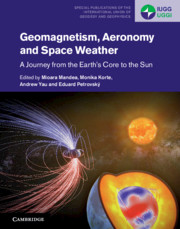Book contents
- Geomagnetism, Aeronomy and Space Weather
- Special Publications of the International Union of Geodesy and Geophysics Series
- Geomagnetism, Aeronomy and Space Weather
- Copyright page
- Contents
- Contributors
- Preface
- Part I Introduction
- Part II Geomagnetic Field
- Part III Spatial and Temporal Variations of the Geomagnetic Field
- Part IV Space Weather
- Part V Magnetic Fields beyond the Earth and beyond Today
- 17 Magnetic Field Evolution in Terrestrial Bodies from Planetesimals to Exoplanets
- 18 Solar Variability
- 19 Long- and Short-Term Geomagnetic Prediction
- Index
- References
18 - Solar Variability
Causes, Current Understanding, Prospects for the Future
from Part V - Magnetic Fields beyond the Earth and beyond Today
Published online by Cambridge University Press: 25 October 2019
- Geomagnetism, Aeronomy and Space Weather
- Special Publications of the International Union of Geodesy and Geophysics Series
- Geomagnetism, Aeronomy and Space Weather
- Copyright page
- Contents
- Contributors
- Preface
- Part I Introduction
- Part II Geomagnetic Field
- Part III Spatial and Temporal Variations of the Geomagnetic Field
- Part IV Space Weather
- Part V Magnetic Fields beyond the Earth and beyond Today
- 17 Magnetic Field Evolution in Terrestrial Bodies from Planetesimals to Exoplanets
- 18 Solar Variability
- 19 Long- and Short-Term Geomagnetic Prediction
- Index
- References
Summary
Solar variability is the origin of space weather. Variations in the rate and kind of energetic output from the Sun cause the variability in the Earth’s space environment, generally termed space weather. The physics of the causes and phenomenology of the evolving solar energetic output has become a major topic of observational and theoretical research. The major components of solar variability are reviewed, together with what are understood to be outstanding questions. Understanding the origin of solar wind streams and their dependence on solar conditions contributes to the predictability of interplanetary processes that affect the Earth’s space environment and are primary drivers of space weather phenomena. The phenomenology of space weather effects resulting from variable solar and interplanetary conditions is well documented, with increasing details uncovered, but the causal processes are less so, as evidenced by the limits of predictability of space weather drivers. Future emphasis must be on improving models, both by the details and resolution that can be achieved and a clearer quantitative understanding of causal relationships, against a background of the essentially stochastic nature of all solar and interplanetary phenomena.
- Type
- Chapter
- Information
- Geomagnetism, Aeronomy and Space WeatherA Journey from the Earth's Core to the Sun, pp. 286 - 311Publisher: Cambridge University PressPrint publication year: 2019



